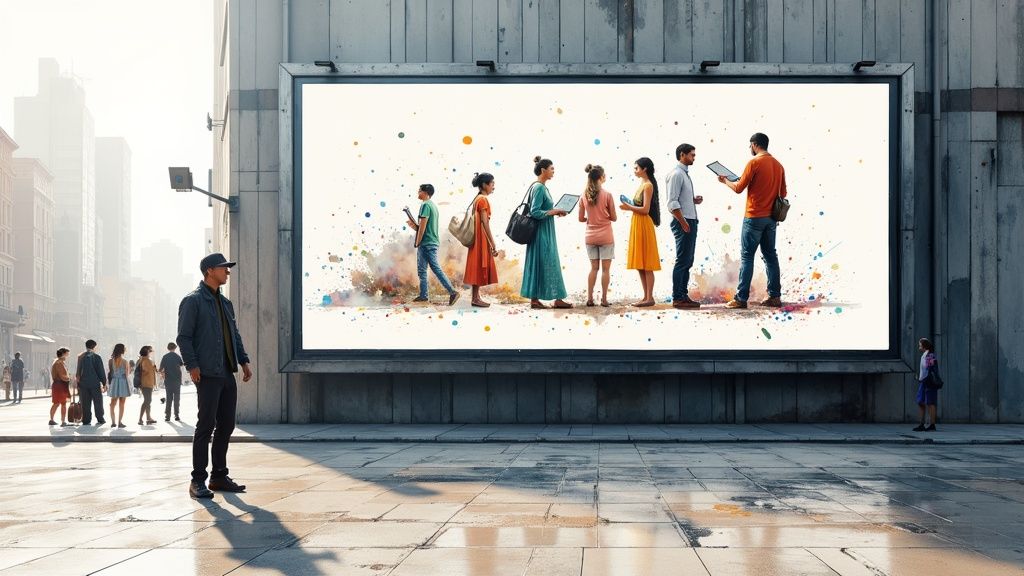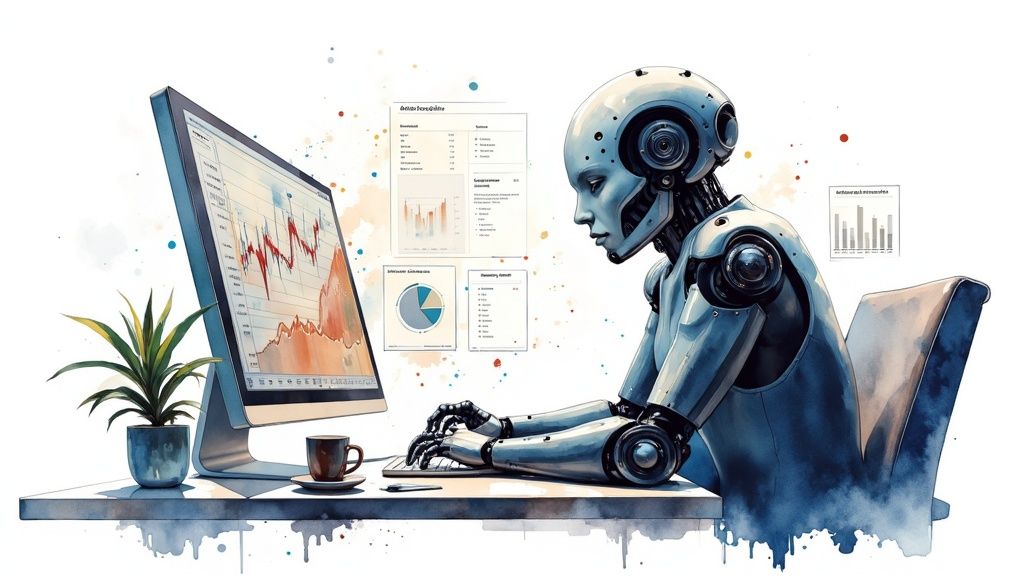The New Frontier of AI-Powered Advertising

AI is fundamentally changing how advertising works. With a 37% adoption rate in marketing - higher than most other industries - AI is quickly becoming essential for connecting with audiences and running effective campaigns. But what's driving this rapid integration of AI in advertising, and how can agencies make the most of it?
Why AI is Transforming Advertising
AI's real strength in advertising comes from its ability to analyze massive amounts of data and spot patterns that humans simply can't detect. This means campaigns can be personalized, optimized, and adjusted in real-time based on actual performance data. For instance, AI systems can track how different audience segments respond to ads, predict which approaches are likely to work best, and automatically shift ad spending to the most effective channels. This frees up creative teams to focus on strategy and developing compelling content rather than getting bogged down in data analysis.
AI also handles time-intensive tasks that traditionally required significant manual effort. Take A/B testing - what once took weeks of careful human monitoring can now be done automatically, with AI quickly identifying which ad versions perform best and adapting campaigns accordingly. The same goes for audience targeting - AI can segment audiences and deliver personalized messages at a scale that would be impossible to achieve manually.
Building a Sustainable AI-Powered Advertising Framework
Successfully bringing AI into your agency requires careful planning and implementation. Here's how to build a framework that makes the most of both AI capabilities and human expertise:
- Data Integration: Start by bringing all your data sources together to give AI systems a complete view of your audience and campaigns. This creates the foundation needed for effective learning and optimization.
- Strategic Tool Selection: Choose AI tools based on your specific challenges and goals. Focus on solutions that directly address your needs, whether that's better targeting, content creation, or campaign performance.
- Human-AI Collaboration: Remember that AI works best as a complement to human skills, not a replacement. Create workflows where AI handles data-heavy tasks while your team focuses on strategy and creativity.
- Continuous Optimization: Stay flexible and keep learning. Regularly review how your AI-powered campaigns are performing and adjust your approach based on real results.
Real-World Applications of AI in Advertising
We're already seeing how AI is improving advertising results in practical ways. AI-powered chatbots now handle customer service and lead generation, while predictive systems help forecast campaign performance and optimize spending. These aren't just theoretical benefits - agencies are getting measurable results from these applications today. For more insights, check out: AI in advertising: The future is now and it's pretty smart.
AI offers exciting new possibilities for advertising agencies. By thoughtfully implementing this technology and maintaining a culture of experimentation, agencies can achieve new levels of campaign performance while building stronger connections with their audiences. The key is finding the right balance between AI's analytical capabilities and the human elements that make advertising truly resonate.
Mastering Personalization Through Machine Learning
AI has immense potential for advertising analytics and campaign optimization, as covered earlier. Building on this foundation, let's explore how machine learning enables a critical capability: creating genuinely personalized ad experiences that connect with individual viewers.
Why Personalization Matters in the Age of AI
People see hundreds of ads every day, making it harder than ever to capture their attention. Machine learning helps solve this by analyzing detailed user data - from browsing behavior to purchase history - to understand individual preferences and deliver relevant ads. When someone frequently shops for running shoes online, for example, showing them targeted athletic wear promotions is far more effective than generic ads. This personalized approach consistently drives higher engagement and conversion rates.
Implementing AI-Powered Personalization: A Practical Guide
Getting started with personalization requires a clear strategy. One effective approach is building dynamic campaigns that adapt in real-time based on user interactions. For instance, an ad could automatically update its messaging to reflect products someone recently viewed on your website. This keeps the content fresh and relevant.
Machine learning also enables much more precise audience targeting. Rather than relying on broad demographic segments, AI can identify specific micro-groups within your audience based on shared behaviors and interests. This allows you to craft messages that speak directly to each group's unique needs and motivations.
Building Trust and Addressing Privacy Concerns
While personalization is powerful, it must be balanced with respect for user privacy. Being transparent about data usage and giving people control over their ad preferences helps build trust. Clear privacy policies and robust data security are essential. Simple options that let users manage how their information is used for personalization can make them feel more comfortable with targeted advertising.
Measuring the Impact of Personalization
To improve personalization over time, closely track key metrics like click-through rates, conversions, and customer lifetime value. This data shows which approaches are working best and helps refine your AI models and targeting. The insights create a feedback loop for continuously enhancing campaign performance and delivering increasingly relevant experiences that resonate with your audience.
From Manual to Automated: How AI is Changing Lead Generation

Beyond enhancing customer engagement, AI is reshaping how agencies find and connect with potential clients. Marketing teams are seeing real results - with some reporting 50% more qualified leads while spending less on acquisition. This isn't just about adding new tools - it's about fundamentally improving how agencies identify and nurture prospects through smart automation.
Modern Chatbots: More Than Just FAQ Machines
The evolution of AI chatbots shows how far lead generation has come. Today's chatbots use advanced natural language processing to have meaningful conversations with website visitors. They can assess lead quality, provide detailed product information, and even handle appointment scheduling - all without human intervention. This explains why 55% of B2B marketers report strong results from these tools. The real value comes from how chatbots handle routine inquiries, giving sales teams more time to focus on closing deals with qualified prospects.
Finding the Right AI Tools for Your Goals
Success with AI requires careful consideration of which tools actually fit your needs. Each agency should examine their specific challenges and objectives when selecting AI solutions. For instance, an e-commerce agency might get better results from AI that personalizes product recommendations based on browsing behavior, while a B2B firm might need different capabilities. What works for one company may not work for another, even within the same industry.
Making AI Work With Your Existing Systems
Getting the most from AI means connecting it smoothly with your current CRM and marketing tools. This creates a complete view of how leads interact with your business across different touchpoints, helping optimize your outreach efforts. To measure success accurately, focus on these key metrics:
- Lead Volume: How many qualified leads come through AI-powered channels
- Conversion Rates: What percentage of leads become customers
- Cost Per Lead: How AI-driven acquisition costs compare to traditional methods
- Customer Lifetime Value: The long-term revenue potential of AI-generated leads
By carefully tracking these numbers, agencies can fine-tune their approach and prove the actual business impact of their AI investments. This data-driven method helps teams adapt to market changes while staying focused on what matters most - finding and nurturing the right prospects who will become valuable long-term customers.
Using AI to Boost Email Marketing Results

Email marketing is getting smarter thanks to AI's ability to analyze data and create personalized campaigns. Gone are the days of basic mass emails - AI now helps marketers understand exactly what resonates with different audience segments. For example, by examining past campaign performance and subscriber behavior, AI can predict which content will get the best response from specific groups. This means emails feel more like one-on-one conversations rather than generic broadcasts.
Creating Content That Connects
AI takes email content optimization beyond simple A/B testing. The technology can now adjust email elements in real-time based on how individuals interact with messages. Instead of using the same content for everyone, marketers can customize the writing style, offers, and overall message for each recipient. This personal touch leads to better open rates, more clicks, and higher conversion rates.
Sending at the Perfect Time
Getting the timing right makes a big difference in email success. AI analyzes when each subscriber typically checks and engages with emails. For instance, if someone regularly opens messages during their evening commute, AI will schedule delivery for that specific window. This data-driven approach replaces guesswork with precision, making emails more likely to be seen and acted upon.
Smarter Testing and Optimization
AI enables continuous improvement through sophisticated testing. The technology can run multiple A/B tests simultaneously on everything from subject lines to calls-to-action, learning what works best for different audience segments. This goes deeper than basic split testing by allowing marketers to fine-tune every email component using real performance data. The result is campaigns that stay fresh and effective over time. For more email marketing tips, check out: How to master email marketing...
Tools That Make AI Email Marketing Work
Several email platforms now offer AI capabilities that put these advances within reach. Key features include smart subject line writing, dynamic content creation, send time optimization, and detailed performance tracking. Here are the core AI tools that help marketers succeed:
| Feature | Description |
|---|---|
| Predictive Analytics | Forecasts email performance based on historical data and user behavior. |
| Dynamic Content Generation | Creates personalized email content tailored to individual subscriber preferences. |
| Automated A/B Testing | Continuously tests and refines email elements for optimal performance. |
| Send-Time Optimization | Determines the best time to send emails to each subscriber. |
By putting these AI capabilities to work, marketers can create email campaigns that truly connect with audiences. The result is stronger relationships with customers, better conversion rates, and improved business outcomes.
How AI Improves Campaign Optimization
AI is fundamentally changing how agencies optimize their advertising campaigns. By analyzing vast amounts of data in real-time, AI helps marketers spot hidden patterns and make smarter decisions that boost campaign performance. Leading agencies are moving away from manual optimization to let AI handle continuous campaign adjustments, resulting in significantly better ROI.
Using AI to Predict Campaign Success
One of AI's most valuable applications is predicting how campaigns will perform. AI systems analyze past campaign data, market conditions, and economic factors to forecast results before launch. This helps marketers make informed decisions about budget allocation, bidding strategies, and targeting from day one. For instance, AI can determine which creative elements will connect best with specific audience segments, taking the guesswork out of campaign planning.
Automated Optimization in Real Time
The advertising world moves fast, with consumer behaviors changing quickly. AI excels at adapting campaigns instantly as conditions shift. The technology continuously monitors key metrics and automatically adjusts bids, reallocates budgets between channels, and updates creative elements to maintain peak performance. When an ad starts to underperform, AI can pause it immediately and swap in better-performing content, preventing wasted spend.
Better Audience Targeting Through AI
AI takes audience segmentation to a new level of precision. Rather than relying on basic demographics, AI identifies subtle patterns in how people behave online and what interests them. This creates highly specific audience segments based on shared characteristics like shopping habits and browsing activity. By delivering ads to the most receptive viewers at optimal times, AI-powered targeting drives higher engagement and conversion rates.
Connecting AI Tools With Marketing Systems
To get the most from AI in advertising, marketers need to thoughtfully integrate AI tools with their existing marketing technology. This means selecting AI solutions that work smoothly with current CRM and analytics platforms to provide a complete view of campaign performance and customer interactions. With this comprehensive data foundation, marketers can further refine their targeting and messaging. You might be interested in: Understanding the Importance of Quality Content to create content that resonates with AI-defined audience segments. The combination of strong content and smart AI-powered delivery helps maximize advertising ROI.
Preparing for the Future of AI in Advertising

The possibilities we're seeing with AI in advertising today are just early signals of much bigger changes ahead. Industry forecasts predict the global AI marketing market will reach $107 billion by 2028, creating huge opportunities for agencies ready to adapt. To stay competitive, agencies need to do more than just keep up with trends - they need to actively shape how AI fits into their advertising strategies.
Investing in the Right AI Technologies
With new AI tools and platforms constantly emerging, agencies face important choices about which technologies to adopt. This requires developing clear criteria for evaluating AI solutions based on specific business needs and goals. Smart technology investment goes beyond just buying software - it means building the right technical infrastructure and expertise to use these tools effectively. The key is choosing solutions that solve real problems while setting up the foundation for future growth.
Building AI-Ready Teams
Having the right technology is only part of the equation - success with AI requires people who know how to use it well. This means training teams to work alongside AI tools, understand data insights, and blend human creativity with AI capabilities. Creating an AI-ready culture is equally important. Teams need to feel comfortable experimenting with new approaches, learning continuously, and adapting their roles as AI capabilities expand.
Navigating the Ethical Considerations of AI
As AI systems become more advanced, paying attention to ethics becomes critical. Key priorities include protecting user privacy, making AI decisions transparent, and preventing algorithmic bias. Agencies must create clear guidelines for responsible AI use that build trust with consumers. This includes being open about how AI is used in campaigns and taking concrete steps to protect user data and privacy.
Measuring Long-Term Success in an AI-Driven Landscape
Traditional advertising metrics don't fully capture the impact of AI-powered campaigns. Agencies need new ways to measure success that go beyond basic metrics like click-through rates. This means developing KPIs that track long-term brand building, customer lifetime value, and AI's overall business impact. A solid measurement framework helps prove AI's ROI and ensures strategies align with bigger business goals.
Aeon, a next-generation video creation platform powered by AI, helps agencies adapt to these changes. The platform transforms text, audio and video into engaging content at scale, saving time while expanding digital reach. Visit https://www.project-aeon.com to learn how Aeon can strengthen your agency's capabilities in the AI era.